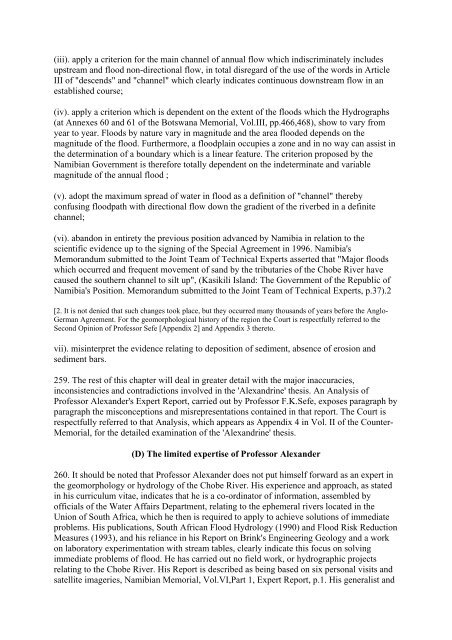botswana/namibia - Cour international de Justice
botswana/namibia - Cour international de Justice
botswana/namibia - Cour international de Justice
You also want an ePaper? Increase the reach of your titles
YUMPU automatically turns print PDFs into web optimized ePapers that Google loves.
(iii). apply a criterion for the main channel of annual flow which indiscriminately inclu<strong>de</strong>s<br />
upstream and flood non-directional flow, in total disregard of the use of the words in Article<br />
III of "<strong>de</strong>scends" and "channel" which clearly indicates continuous downstream flow in an<br />
established course;<br />
(iv). apply a criterion which is <strong>de</strong>pen<strong>de</strong>nt on the extent of the floods which the Hydrographs<br />
(at Annexes 60 and 61 of the Botswana Memorial, Vol.III, pp.466,468), show to vary from<br />
year to year. Floods by nature vary in magnitu<strong>de</strong> and the area floo<strong>de</strong>d <strong>de</strong>pends on the<br />
magnitu<strong>de</strong> of the flood. Furthermore, a floodplain occupies a zone and in no way can assist in<br />
the <strong>de</strong>termination of a boundary which is a linear feature. The criterion proposed by the<br />
Namibian Government is therefore totally <strong>de</strong>pen<strong>de</strong>nt on the in<strong>de</strong>terminate and variable<br />
magnitu<strong>de</strong> of the annual flood ;<br />
(v). adopt the maximum spread of water in flood as a <strong>de</strong>finition of "channel" thereby<br />
confusing floodpath with directional flow down the gradient of the riverbed in a <strong>de</strong>finite<br />
channel;<br />
(vi). abandon in entirety the previous position advanced by Namibia in relation to the<br />
scientific evi<strong>de</strong>nce up to the signing of the Special Agreement in 1996. Namibia's<br />
Memorandum submitted to the Joint Team of Technical Experts asserted that "Major floods<br />
which occurred and frequent movement of sand by the tributaries of the Chobe River have<br />
caused the southern channel to silt up", (Kasikili Island: The Government of the Republic of<br />
Namibia's Position. Memorandum submitted to the Joint Team of Technical Experts, p.37).2<br />
[2. It is not <strong>de</strong>nied that such changes took place, but they occurred many thousands of years before the Anglo-<br />
German Agreement. For the geomorphological history of the region the <strong>Cour</strong>t is respectfully referred to the<br />
Second Opinion of Professor Sefe [Appendix 2] and Appendix 3 thereto.<br />
vii). misinterpret the evi<strong>de</strong>nce relating to <strong>de</strong>position of sediment, absence of erosion and<br />
sediment bars.<br />
259. The rest of this chapter will <strong>de</strong>al in greater <strong>de</strong>tail with the major inaccuracies,<br />
inconsistencies and contradictions involved in the 'Alexandrine' thesis. An Analysis of<br />
Professor Alexan<strong>de</strong>r's Expert Report, carried out by Professor F.K.Sefe, exposes paragraph by<br />
paragraph the misconceptions and misrepresentations contained in that report. The <strong>Cour</strong>t is<br />
respectfully referred to that Analysis, which appears as Appendix 4 in Vol. II of the Counter-<br />
Memorial, for the <strong>de</strong>tailed examination of the 'Alexandrine' thesis.<br />
(D) The limited expertise of Professor Alexan<strong>de</strong>r<br />
260. It should be noted that Professor Alexan<strong>de</strong>r does not put himself forward as an expert in<br />
the geomorphology or hydrology of the Chobe River. His experience and approach, as stated<br />
in his curriculum vitae, indicates that he is a co-ordinator of information, assembled by<br />
officials of the Water Affairs Department, relating to the ephemeral rivers located in the<br />
Union of South Africa, which he then is required to apply to achieve solutions of immediate<br />
problems. His publications, South African Flood Hydrology (1990) and Flood Risk Reduction<br />
Measures (1993), and his reliance in his Report on Brink's Engineering Geology and a work<br />
on laboratory experimentation with stream tables, clearly indicate this focus on solving<br />
immediate problems of flood. He has carried out no field work, or hydrographic projects<br />
relating to the Chobe River. His Report is <strong>de</strong>scribed as being based on six personal visits and<br />
satellite imageries, Namibian Memorial, Vol.VI,Part 1, Expert Report, p.1. His generalist and

















